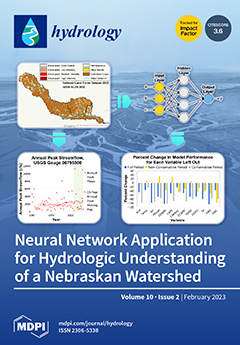For this study, conducted in a semiarid (318 mm) rangeland setting in the Chihuahuan Desert region in northern Mexico, we evaluated the seasonal and interannual variability of precipitation, vegetation, and groundwater relations. Between 2012 and 2014, a series of soil and water conservation
[...] Read more.
For this study, conducted in a semiarid (318 mm) rangeland setting in the Chihuahuan Desert region in northern Mexico, we evaluated the seasonal and interannual variability of precipitation, vegetation, and groundwater relations. Between 2012 and 2014, a series of soil and water conservation practices (e.g., land imprinting, contour furrows, and planting of native shrub species) were conducted in several areas within the 2500 ha study site. Since 2014, the site has been gradually instrumented to monitor several hydrologic variables, including rainfall, soil water content, and groundwater. The Normalized Difference Vegetation Index (
NDVI) and Normalized Difference Infrared Index (
NDII) vegetation indices were used to evaluate vegetation conditions between 2007 and 2021, before and after the treatment. Soil water content and groundwater began to be monitored in 2014 and 2016, respectively. Study results show that
NDVI and
NDII values were higher in the years following the treatment. A negative trend in
NDVI values was observed in the years before restoration and reversed in the post-treatment years. The relatively low levels of soil water content obtained every year followed a seasonal response to precipitation inputs characterized by a quick rise and decline at the 0.2 m depth and a more gradual rise and decline for sensors at 0.5 m and 0.8 m depths. A positive trend in groundwater levels has been observed since the onset of monitoring in 2016, with seasonal groundwater levels rising between 0.7 m and 1.3 m for most years, except for 2020, when levels dropped 1 m. The yearly recharge of the aquifer ranged between 102 mm and 197 mm. The conservation practices employed have positively affected the state of the rangeland ecosystem. The upward trends in
NDVI,
NDII, and groundwater levels observed in the post-treatment years were partly attributed to improved land conditions. The findings of this study contribute to the improved understanding of land use and environmental relations in summer precipitation-dominated rangeland ecosystems.
Full article





